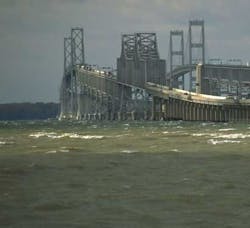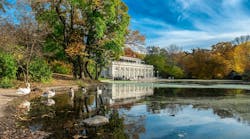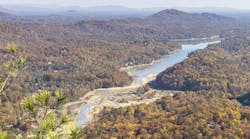Impervious Surfaces Increase Heavy Rain Impact on Chesapeake Bay
Powerful spring storms recently provided evidence of the significant negative impact that impervious surfaces have on the health of the Chesapeake Bay and the streams and rivers flowing into it.
“In our efforts to improve the health of the bay, storm water management continues to be one of our greatest challenges,” said Governor Martin O’Malley. “Storm events of this magnitude underscore the overwhelming negative effect that impervious surfaces such as roads, rooftops and parking lots have on our aquatic environments.”
While this rain is needed to help recharge groundwater levels after a nearly year-long drought, it is responsible not only for regional flooding but also pushing large amounts of sediment and nutrients from lawns, farms and roadways into the bay and its tributaries. Real-time continuous monitoring sites in Maryland’s portion of the bay, available on the Maryland Department of Natural Resources (DNR) Eyes on the Bay website, revealed an immediate spike in overall turbidity levels, indicating a decrease in water clarity due to the volume of sediment and suspended materials entering waterways.
“Our water quality monitoring clearly shows the immediate impact of runoff events on the bay," said Chris Trumbauer, biologist with the Maryland DNR. "To reduce these impacts, we encourage citizens in the bay watershed to capture storm water by installing rain gardens or rain barrels. These are relatively affordable, easy things to do. Every home and business owner can take action on their property to help restore and protect our rivers and treasured bay.”
Residents in the bay watershed are encouraged to take action to lessen the impact of rain events on the bay by: using fertilizer sparingly or only during fall months; utilizing rain barrels and rain gardens to collect and contain roof drainage; and pump out their septic tanks every three to five years. Planting trees and vegetation along streams also help to slow and absorb runoff pollution. For additional information about storm water management best practices, visit www.mde.state.md.us/programs/waterprograms/sedimentandstormwater/index.asp.
Poor water clarity prevents underwater bay grasses, known as submerged aquatic vegetation (SAV), and other aquatic resources from thriving. It is currently the early part of the SAV growing season, when plants require more light to grow and thrive at their full potential. In addition to the pollutants being washed into the bay as a result of rain events, nutrient-laden runoff can fuel mass algal blooms blocking out sunlight and contributing to oxygen-depletion.
Visit Eyes on the Bay at www.eyesonthebay.net for storm impact data, as well as real-time water quality information.
Source: Maryland Department of Natural Resources


